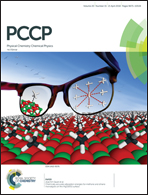Lithium adsorption and migration in group IV–VI compounds and GeS/graphene heterostructures: a comparative study†
Abstract
By means of first-principles calculations, the adsorption and transport properties of lithium (Li) in orthorhombic group IV–VI compounds MX (M = Ge, Sn; X = S, Se) and GeS/graphene heterostructures have been systematically investigated. Strong interactions and distinct charge transfer between Li and compounds MX are observed. The Li diffusion barriers along the zigzag direction are found to be much lower than that along the armchair direction in monolayer and bulk MX, showing distinct anisotropic diffusion features. In particular, monolayer GeS has a lowest barrier of 0.173 eV (zigzag) among them and it will transit from a semiconductor to a metallic state after Li intercalation, indicating fast Li and electron transport properties. As a comparison, the addition of graphene in a GeS/graphene heterostructure could enhance its binding with Li, decrease the Li diffusion barrier and inhibit the volume expansion dramatically, suggesting a potential performance improvement. Our study not only reveals the directional transport properties of Li in MX, but also improves the understanding of the role of graphene in the MX/graphene heterostructure, and shows great potential application in the field of electrode materials.



 Please wait while we load your content...
Please wait while we load your content...